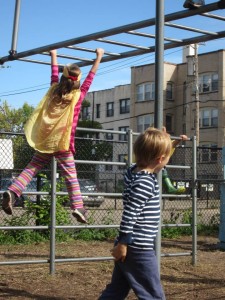 By: Kerry Miller & Mary Hatch, Educational Support
By: Kerry Miller & Mary Hatch, Educational Support
Today brings one of the truly brisk, cold days of autumn, which can also herald a shift in the playtime of the children. The teachers notice more time spent in the elaborate construction of cozy shelters as the outer warmth and light contracts and diminishes. Soon the snow will blanket the play yard, beckoning the children outwards to embrace a new season.
November will also bring a new and exciting activity for the children in the kindergartens. The children will be participating in our sensory “circus” with their teacher and a small group of friends from their class. The whole experience, which the children seem to love, occurs in the movement room and lasts about fifteen minutes. The children will be able to walk the tightrope as a circus acrobat, balance like a prancing pony, etc. While this will certainly be fun and exciting, the other purpose of this activity is to observe the children, in order to determine how best to support their sensory-motor development.
The term ‘sensory processing’ describes the neurological organization of the senses. Usually, when we think of our senses, we can count five: taste, touch, smell, sight, and sound. Actually, there are more, including the senses of movement, gravity, and body position. When our brains process the information we receive through our senses, our nervous systems respond appropriately to incoming stimuli. Thus, we instinctively enjoy cuddling, shift our weight from one foot to another when climbing stairs, slip easily into our coats and mittens, and screech to a halt before crashing into a tree. Not only our physical responses but also our behavioral, emotional, and intellectual responses depend on the smooth integration of all our senses. When a person’s neurological processing is inefficient, however, even performing ordinary tasks and responding to ordinary events can be enormously challenging.
Our screening time with the children might produce outcomes ranging, for instance, from simply incorporating more jump roping (which teaches the arms and legs to function independently of one another) into the classroom activities, to providing a referral to an occupational therapist—who may comprehensively address and support challenges in sensory processing. We will be joined in our observations by Success in Motion Therapist Naomi Siegal, an experienced occupational therapist who has provided support for some of our families in the past.
If you have any questions or would like more information, please feel free to contact us. We are grateful to be able to offer you this useful window into your child’s unfolding development.

